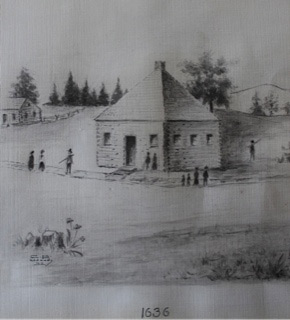Editha Stebbins went with her brother Edward to listen to Thomas Hooker, a charismatic Puritan preacher in Braintree, England. When Rev. Hooker sailed to the new colony of Massachusetts, many of his followers went with him, including Edward Stebbins and his sister Editha.
Cambridge was too crowded for the newcomers. After four years in Cambridge, Rev. Hooker led them into the wilderness, where they built a city on the banks of the
Connecticut River. They named it Hartford.

Drawing by S. H. Clark: frontispiece of "Hartford in the olden time; its first thirty years" database, Internet Archive (accessed 10 Nov 2013) extracted from book of the same name by Isaac William Stuart. Hartford, F. A. Brown, 1853. (Kilburn Del was a wood engraver of some fame c. 1853)
Editha married Robert Day, a young Deacon in their newly built village
church. They had four children in just twelve years of marriage, and then Robert Day died.
John Maynard, another Puritan Deacon, and a bachelor all those years, wed
Editha soon after Robert Day died. He must have been a good father to
Robert's children, for the youngest child named his own son Maynard Day in
later years. Editha didn't have any more children, and John Maynard died ten years
later, when Editha's children were grown. Elizur Holyoke, a widower from
Springfield, Massachusetts married Editha that year. Editha's three adult
children married that same year. The death of Elizur's wife had left him with six young children to raise, but now he had help - Editha.

Elizur's youngest child, Mary, was only two
years old when Editha came into their lives. After founding a town in the wilderness and building it up for twenty years, Editha now lived in a well developed town, and plenty of resources to raise her new family.
Fifteen years later, in 1675, when Elizur's children were grown, the Indians burned Springfield. Springfield thought they had a fool-proof plan - their militia would go to the aid of nearby towns, and vice versa. So when they had a message to come help Hadley, forty-five of the strongest men in Springfield's militia marched to their defense.
While the militia were gone, a
messenger on a lathered horse arrived to shout a warning: the Indians were
not attacking Hadley - they were going to attack Springfield. Editha and
Elizur, carrying food and a few valuables, fled to the nearest fortified
house, prepared for just such an attack.
The night was quiet, the morning was ordinary, and a few people left the
fortified houses - why stay cooped up like sardines in a box, the whole town
squeezed into three houses, when nothing was happening? Then a wounded scout
rode up to gasp a warning with his dying breath - the Indians were right
behind him. They first burned the corn mill and the saw mill, then looted
and burned three fourths of the homes and barns. When Springfield's militia returned,
it was too late. The town was in smoldering ruins.
Dissuaded by the Massachusetts governor from abandoning their settlement,
the people with homes left standing shared their roofs with those who were
burned out. Three quarters of the town was living with one fourth of the
town that winter, and food was scarce.
Editha lived through the attack, and her house was left standing - and
crowded to the rafters. Click on "Editha Stebbins" link at the top of this page to see the rest of
her story, with timeline and footnotes.
A footnote for those working on their family trees: I found Editha's story of surviving the Indian attack and then sharing her home and food all winter by reading the history of Springfield. I had previously skipped investigating 'background' material like town histories, and I almost missed Editha's amazing life.